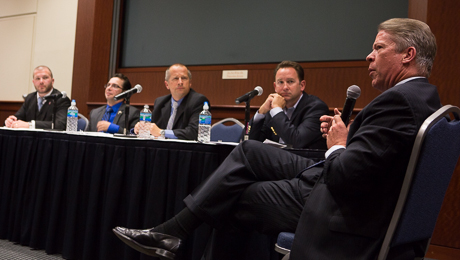By Lauren Ingeno
Reading a story in the New York Times or watching a report on the 6 o’clock news—it’s the closest many Americans will ever come to seeing a war zone.
It means war correspondents have a critical obligation to the public, helping to ensure citizens receive the facts and understand the implications of an intensely complex subject.
But when told through a journalist’s camera lens, the picture of war is not always complete—or accurate, said GW Veterans President Mitchell Bent during a panel discussion at George Washington University’s Marvin Center Amphitheater on Wednesday night.
“Americans need to understand that there is more to every story,” said Mr. Bent, a senior in the Elliot School of International Affairs who served two tours in Iraq. “That 30-minute segment on TV cannot come close to covering the whole situation.”
During “War in the Media: Recording History”—a GW Veterans Week event hosted by the Office of Military and Veteran Student Services—Mr. Bent, student veteran Dominic Amaral, U.S. Navy Captain (retired) James Graybeal and GW Professor Sean Aday engaged in a heated conversation about the intersection of soldiers’ real-life experiences and the reporters who tell about them.
The discussion was moderated by CBS News' Chief White House Correspondent Major Garrett, a distinguished fellow in the GW School of Media and Public Affairs.
When it comes to telling the “full story” of war, the panelists seemed to agree that this is a necessity, but really impossible for any reporter, for reasons both in and out of their control.
Mr. Amaral lamented the fact that many graphic, yet important, images from war zones “fall victim to censorship” and are never shown to the public. When he served in Iraq, Mr. Amaral said a reporter who was embedded in his troop had his credentials taken away after he shot photographs of broken military vehicles.
“If you’re not going to send those pictures home—that this is what it looks like when a car bomb wipes out a market—to me, that’s the biggest travesty,” said Mr. Amaral, a senior in the Columbian College of Arts and Sciences. “Obviously you’re not going to put an image of a mangled body on the news. But these things happen. And that’s why when you walk around a college campus, people talk so casually about war, because they just don’t ever see it.”
The censorship can come from both ends: the news organizations as well as the military.
Mr. Graybeal, the associate director for public affairs at the Military Compensation and Retirement Modernization Commission, explained that embedded journalists are required to sign a set of rules that restrict them from revealing any inappropriate details that would put soldiers at risk. But, he said, just as journalists have an obligation to keep the public informed, so do military commanders.
“Stories about broken equipment are exactly the types of stories we want to tell. We have an obligation to tell the unblemished story, so the citizens can be informed voters,” Mr. Graybeal said.
He explained that military personnel should help journalists understand the broader, operational picture of war, rather than just episodic events.
Mr. Amaral and Mr. Bent had vastly different experiences with embedded journalists.
Mr. Bent said he felt “scrutinized and watched” by the journalist who was living with his troop, and he kept reporters at “an arm’s length.”
He said he feels that war reporters can be biased, and are more likely to tell about military mistakes, rather than any of the “good days”—like when he and his fellow soldiers built schools in Iraq.
But Mr. Amaral thought differently.
“I really don’t understand this ‘good day’ mantra. There were no good days,” he said. “Was nobody killed today, so that’s a win?”
Unlike Mr. Bent, Mr. Amaral said he and those in his troop enjoyed the company of their embedded reporter.
“We loved the guy. He was a steady break from all the routine norms,” he said. “We treated him as we treated each other.”
While both veterans acknowledged that it is important for the American public to better understand what happens during war, no image, article or video could ever provide a truly accurate depiction, they said.
But that doesn’t mean journalists should stop trying, said Dr. Aday, director of GW’s Institute for Public Diplomacy and Global Communication.
“Nobody is saying that showing more casualty coverage means that you’re going to understand what somebody went through in that situation. That’s impossible,” he said. “It’s about showing the whole, much richer picture of war. And there is a larger, societal reason to do that. It’s not the fantasy of ‘Oh, I’m going to understand what they went through.’ It’s that society needs to have a better understanding that people are going through that.”


